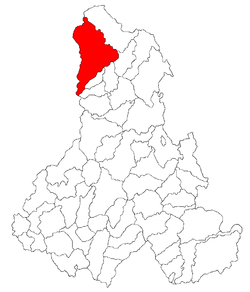- Toplița
-
For the commune in Hunedoara County, see Topliţa, Hunedoara. For the village in Argeş County, see Mălureni. For the village in Sălaj County, see Letca.
Toplița
Maroshévíz— Municipality — Location of Topliţa Coordinates: 46°55′25″N 25°20′45″E / 46.92361°N 25.34583°ECoordinates: 46°55′25″N 25°20′45″E / 46.92361°N 25.34583°E Country  Romania
RomaniaCounty Harghita County Status Municipality Government – Mayor Niculae Baciu (Ind.) Population (2002) – Total 15,880 Time zone EET (UTC+2) – Summer (DST) EEST (UTC+3) Website http://www.toplita.info/ Toplița (Romanian pronunciation: [ˈtoplit͡sa]; Hungarian: Maroshévíz, Hungarian pronunciation: [’mɒroʃheːviːz]) is a city in Harghita County, Romania.
The settlement has had multiple name changes: Taplócza, Toplicza, Gyergyó-Toplicza, from February 3, 1861 Oláh-Toplicza, or "Romanian Toplița", then from January 1, 1907 Maroshévíz, until 1918, when it received the Romanian name Toplița Română. Both the Hungarian and the Romanian names mean "hot water spring"; the latter is a Romanian word of Slavic origin.
The city administers eight villages: Călimănel (Kelemenpatak), Luncani (Lunkány), Măgheruș (Magyaros), Moglăneşti (Moglán), Secu (Székpatak), Vâgani (Vugány), Vale (Válya) and Zencani (Zsákhegy).
Contents
Demographics
According to the last census from 2002 there were 15,880 people living in the city.
Of this population, 71.1% are ethnic Romanians, while 25.43% are ethnic Hungarians (primarily Székely), 3.06% ethnic Roma and 0.41% others.[1]
Among the villages which are the part of this municipality, there are large ethnic Hungarian minorities in Măgheruș (34%), Moglănești (21.5%), Secu (29.7%) and Zencani (23.7%).
Geography
Topliţa is located in eastern Transylvania on the upper reaches of the Mureş, more precisely in the northwestern corner of Harghita County. It is situated at an altitude of 650 m above sea level, on the Giurgiului plain between the mountains of Giurgiului, Gurghiului and Călimani. The nearest towns are Borsec (26 km), Gheorgheni (38 km) and Reghin (69 km).
History
The settlement was founded in 1567 by Petrichevitch Horváth Kozma on land owned by Bánffy Pál. He gave the land to three Moldavian peasant families and named the place Taplócza[citation needed].
The region was Simon Bán's property until 1228, then passed on to the Bánffy family, who managed to keep their enormous properties until 1945[2]. As a feudal domain, the area was not part of any of the Székely seats (sedes judiciaria).
In 1658, Gyergyó-Toplicza was entirely destroyed by Moldavian units led by Pintea. After 1660, the Bánffys brought 391 Romanian peasant families from Deda onto these lands. Around 1710, rafting started on the Mureş river. Due to this profitable enterprise, Toplicza and its inhabitants started growing and evolving in both wealth and numbers. The first European census, ordered by Joseph II, took place in Toplicza on 20 November 1785. Census results showed 227 farms, 23 free and 231 thrall families who belonged to 22 lords. Baron Bornemissza János owned 52 of these families, while Baron Kemény Simon owned 30 and Count Teleki Mihály 18.
In 1868, eight "parraediums" belonged to Oláh-Toplicza: Kelemenpatak, Nyírmező, Csobotány, Mănăstirea, Vugány, Moglán, Plopiş and Magyarós; at the time Válya was already part of the settlement. Nowadays, it comprises Valea, Zencani, Vâgani, Secu, Moglăneşti, Măgheruş and Luncani.
Until the Treaty of Trianon of 1920, it was part of Maros-Torda County in the Austria-Hungary. In 1920, it became part of Romania. In 1940, the second Vienna Award granted Northern Transylvania to Hungary and the town formed part of Hungary until 1944. After Soviet occupation, the Romanian administration returned and the town officially returned to Romanian control in 1947.
During World War I, Topliţa and its periphery witnessed cruel fighting. The Romanian monument in Secu is the tomb of 771 Romanian soldiers, while in the Hungarian Soldiers Cemetery 450 Hungarian soldiers were buried.
In 1952 Topliţa was declared a town, and in 2002 it was declared a municipality.
Buildings
- 1658 Mănăstirea Doamnei
- 1847 Sf. Ilie monastery
- Sept. 22 1867-Aug. 21 1869 a Roman Catholic church in the vicinity of an old wooden church
- 1867-1903 Orthodox Church
- 1870 Roman Catholic Denominational School
- 1895 Calvinistic Church
- 1896 Hungarian State School, founded in the Valea section
- 1903-1907 Urmánczy castle, today the town's Ethnographic Museum
- 1928-1929 Greek Catholic Church in the Cornişa section, built to replace the 1777 wooden church which was moved to the nearby Gălăuţaş village.
Natives
- Miron Cristea (1868–1939), the first Patriarch of the Romanian Orthodox Church, and the Prime Minister of Romania between 1938 and 1939.
References
Harghita County, Romania Cities Miercurea-Ciuc (county seat) · Gheorgheni · Italic text Odorheiu Secuiesc · Topliţa

Towns Băile Tuşnad · Bălan · Borsec · Cristuru Secuiesc · Vlăhiţa
Communes Atid · Avrămeşti · Bilbor · Brădeşti · Căpâlniţa · Cârţa · Ciceu · Ciucsângeorgiu · Ciumani · Corbu · Corund · Cozmeni · Dăneşti · Dârjiu · Dealu · Ditrău · Feliceni · Frumoasa · Gălăuţaş · Joseni · Lăzarea · Leliceni · Lueta · Lunca de Jos · Lunca de Sus · Lupeni · Mădăraş · Mărtiniş · Mereşti · Mihăileni · Mugeni · Ocland · Păuleni-Ciuc · Plăieşii de Jos · Porumbeni · Praid · Racu · Remetea · Săcel · Sâncrăieni · Sândominic · Sânmartin · Sânsimion · Sântimbru · Sărmaş · Satu Mare · Secuieni · Siculeni · Şimoneşti · Subcetate · Suseni · Tomeşti · Tulgheş · Tuşnad · Ulieş · Vărşag · Voşlăbeni · Zetea
Categories:- Populated places in Harghita County
- Cities in Romania
- Populated places established in 1567
Wikimedia Foundation. 2010.


